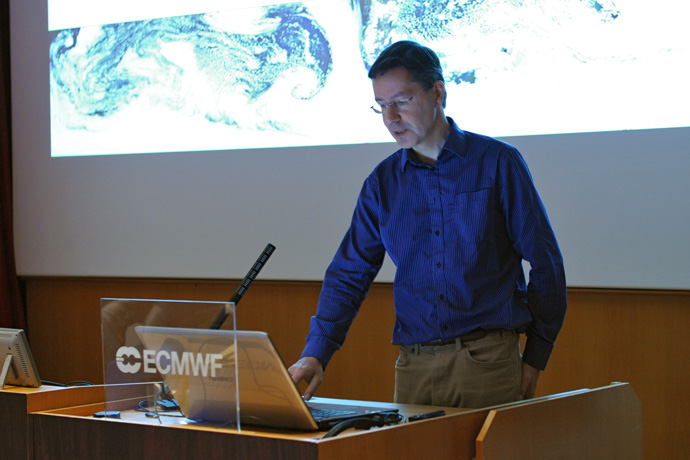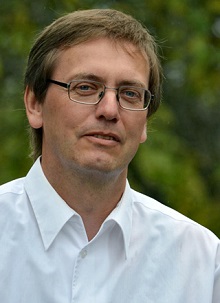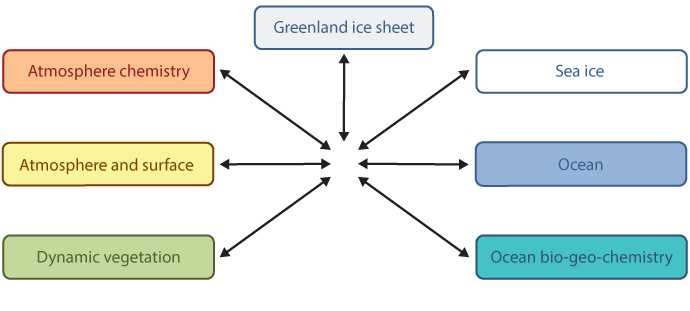

ECMWF scientist Richard Forbes gave an invited talk on ‘Reducing cloud and radiation systematic errors in global NWP and climate models’ at the EC-Earth meeting.
More than 50 scientists from the European EC-Earth consortium met at ECMWF from 21 to 23 May to discuss how to develop the Earth system model they use to make climate predictions and projections.
After years of preparation, EC-Earth has begun to run simulations as part of a climate model intercomparison project expected to feed into the next IPCC report.
“We are delighted that we are now running CMIP6 simulations while continuing to work on model configurations and on the next version of the EC-Earth model, EC-Earth 4,” says Ralf Döscher, the chair of the EC-Earth steering committee.
Link to ECMWF
 The EC-Earth model uses ECMWF’s Integrated Forecasting System (IFS) for the atmosphere–land component but complements this with other model components to simulate the full range of Earth system interactions that are relevant to climate.
The EC-Earth model uses ECMWF’s Integrated Forecasting System (IFS) for the atmosphere–land component but complements this with other model components to simulate the full range of Earth system interactions that are relevant to climate.
“The idea behind EC-Earth was to use ECMWF’s highly successful weather forecasting model as the basis of a climate model,” says Ralf, who is also the Head of the Rossby Centre, the Swedish Meteorological and Hydrological Institute’s climate modelling research unit.
“That is why we are using a suitably modified version of ECMWF’s seasonal forecasting system for the atmosphere–land component of our Earth system model, and in the future we will use the OpenIFS model to benefit from frequent upgrades and a broader user community.”
OpenIFS is a portable version of the IFS for use by universities, research institutes and the meteorological services of ECMWF’s Member and Co-operating States.

The maximum configuration in which EC-Earth’s Earth system model is expected to run comprises seven components, which are all coupled to each other. The system is flexible: different combinations of components can be used for different purposes.
Reducing biases
How can a numerical weather prediction model serve as the basis of a climate model? Fundamentally, both aim to simulate Earth system processes as realistically as possible to be able to make predictions of how they will evolve. And research shows that improvements in NWP models can also lead to better results on the kind of timescales relevant to climate.
An example is recent work at the Centre to reduce shortwave radiation biases in the IFS. In a talk at the EC-Earth meeting, ECMWF scientist Richard Forbes showed similar biases in both the medium-range and long-range forecasts and explained how they were linked to the convection and cloud physics used in the model.
“Since many of the cloud errors that affect radiation are similar for different models, different resolutions and across forecast timescales, using observations to understand and reduce the biases in short forecasts from global numerical weather prediction models can also help to reduce those same biases in longer-range predictions from climate models,” Richard says.

The plots show how the annual mean top‐of‐atmosphere upwelling shortwave radiation bias (W m-2) from IFS Cycle 43r1, compared to satellite observations from CERES-EBAF, is remarkably similar for a year‐long free‐running 4-member ensemble run averaged over the years 2000–2004 representative of the model climate (left) and operational 24-hour forecasts averaged for the year October 2016 to September 2017 (right). Red areas indicate regions with an overestimated shortwave albedo (too much reflection) and blue areas indicate regions where too little radiation is reflected.
It remains true that models fine-tuned for successful numerical weather prediction may not be optimal for climate timescales. That is why EC-Earth adjusts tuning and conservation features in the IFS for its own purposes.
“We run the model over recent decades and pre-industrial periods and compare the results with the observational record. This can tell us which aspects of the model we have to adjust to optimise our results,” says Ralf.
“Model shortcomings revealed in such experiments can in turn feed back into the development of the IFS.”
Slow Earth system processes
In addition, climate models need to take full account of relatively slow Earth system processes that can be neglected in numerical weather prediction.
For example, what effects will long-term changes in atmospheric composition or ocean bio-geo-chemistry have on the global climate, and vice versa?
All these components can be coupled in the EC-Earth model to reflect their interactions in the Earth system.
The meeting at ECMWF reviewed progress in developing the EC-Earth model. For example, a dynamic vegetation model developed largely at Lund University in Sweden now enables the model to simulate the impact of a changing climate on vegetation, and the feedback of changes in vegetation back on the climate.
One reason why this is important is that changes in vegetation entail changes in how much radiation is reflected from the surface. “Previously this was modelled using simplified assumptions, whereas now we can simulate these processes in a more realistic manner,” says Ralf.

Different kinds of vegetation can make the land surface more or less reflective, as illustrated by this satellite image of the Lake Garda region in Italy. (Contains modified Copernicus Sentinel data 2018–19, processed by ESA, CC BY-SA 3.0 IGO)
One of the developments scientists are working on is to possibly adopt a stochastic approach in all EC-Earth components. This reflects the fact that the simulation of any Earth system processes is associated with different degrees of uncertainty.
“A stochastic approach has the potential to improve many features, including the representation of extreme conditions, as is already done in numerical weather prediction,” Ralf notes.
More information on EC-Earth
EC‐Earth brings together 27 research institutes from 10 European countries to collaborate on the development and application of an Earth system model.
Its mission is to “develop and apply an Earth System Model based on ECMWF’s seasonal forecasting system for providing trustworthy climate information to climate services and to advance scientific knowledge on the Earth system, its variability, predictability and long-term changes resulting from external forcing.”
